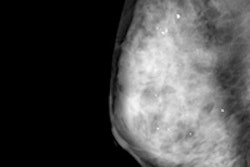In recent years, numerous software applications have become available for registering and managing radiology dosimetry data. For x-ray-based modalities, patient dose information is usually available in image headers or in structured reports that can be stored in PACS; sometimes the dosimetry data are present in DICOM Modality Performed Procedure Step (MPPS) messages, according to presenter Andrea Nitrosi, PhD, of Arcispedale Santa Maria Nuova Hospital IRCCS in Reggio Emilia, Italy.
"The standardization of this information transmission is ongoing within the DICOM standard and the [Integrating the Healthcare Enterprise] framework," Nitrosi explained.
In its research, the Italian group sought to demonstrate how dose monitoring systems integrated with the RIS can enable standardization of image acquisition setups, Nitrosi said. The researchers applied an internally developed software application called Gray Detector to exposure data from a large dataset of full-field digital mammography (FFDM) and digital breast tomosynthesis (DBT) images in their population-based screening program. This allowed them to develop a model that evaluated the influence of exposure parameters on screening outcome.
Based on that analysis, the team then defined areas of intervention to standardize the image acquisition setup (e.g., compression and automatic exposure selection) to achieve a better outcome, according to Nitrosi. After evaluating the effects of this standardization on a sample of about 15,000 women, the researchers achieved a 15% increase in detection rate.
"The key implication of our study is that the analysis of a very large data sample can allow us to standardize, and then optimize, the risk-benefit [ratio] of a screening population that is asymptomatic and potentially healthy," Nitrosi told AuntMinnie.com.



















